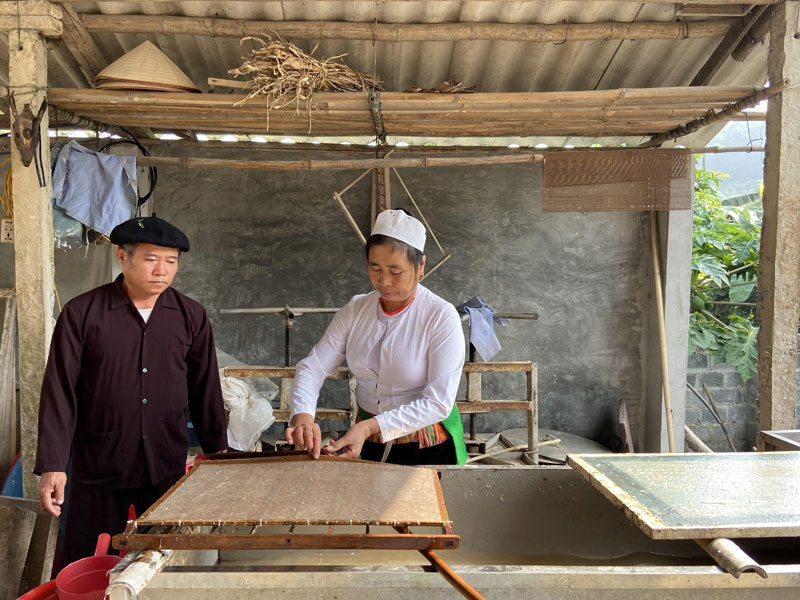
(HBO) - Although a trade village of Do paper making of Muong ethnic people in Suoi Co village, Hop Hoa commune - now Cao Son commune (Luong Son) has not yet been established, it is only a production group, with a passion for the traditional craft, the artisans have been preserving and developing the profession the forefather has left, gradually "recovering” Do paper.
 The artisan making Do paper in Suoi Co village, Hop Hoa
commune - now Cao Son commune (Luong Son) is performing the process of making
paper on the mold.
The artisan making Do paper in Suoi Co village, Hop Hoa
commune - now Cao Son commune (Luong Son) is performing the process of making
paper on the mold.
Do paper is very special paper, so the production process is
not simple. To make paper, it is necessary to go through 35 stages. It takes
half a month from taking materials, soaking and making products. The type of
trees used most to make paper are Do (Aquilaria crassna) and Duong
(Broussonetia papyrifera) (called Rang tree by Muong ethnic people).
The equipment for making Do paper is also gradually improved
to reduce the time and the stages of completion. The main tools are cloth
molds, available in various sizes (30 x 40 cm, 60 x 80 cm, 60 x 120 cm),
cooking pots and machines for stirring materials, tanks for soaking margins and
for lifting up the paper pulp with a crowbar…
After being taken home, the leaves and branches of the
broussonetia papyrifera are removed, the bark is taken to be boiled and soaked
with lime water to make it puree, then it is put in the stirrer into a puree,
filter to get the pure water (also known as the margin), the margin is soaked
in the tank and the paper is lifted up with a crowbar. This stage is usually
undertaken by Muong women. The loose paper pulp is poured on the mold, coated
very thin like the coated rolls, then it is peeled off. Each stack of paper is
pressed and dried. Every 10 kg of fresh bark or 4 kg of dried raw bark will
produce about 120 sheets of paper. The final step is to put the sheets in
layers, depending on the type of paper to use a piece of cork to pulley in the
size of 10 x 20 cm or 20 x 30 cm.
From the skillful hands of the artisans, according to their
own secrets, Do paper is thin but it is tough and durable than the paper made
in the industrial process. It has the
faintly scent of forest trees. If it is stored in a dry place, the paper can be
left for several decades. Therefore, now it is not only a material for
painting, writing, under the creativity of the artisans Do paper has become a product
for tourism development in many parts of the country.
In addition to the Northern provinces, Do paper of Muong
ethnic people in Suoi Co are also trusted to use by the travel and tourism
companies in the Central and Southern regions such as Hue, Hoi An, Da Nang, Lam
Dong ... Currently, the artisan Nguyen Van Chuc continues to search for the
output for the product with the hope to contribute efforts to the craft
villages throughout the country to help Do paper gradually regain its position
in the traditional culture.
With an increasingly vibrant and widespread emulation movement aimed at building cultured residential areas and cultured families, Yen Thuy District has been making steady progress toward improving both the material and spiritual well-being of its people, while fostering a civilized, prosperous, beautiful, and progressive community.
Once lacking recreational spaces and community facilities, Residential Group 2 in Quynh Lam Ward (Hoa Binh City) has recently received attention for the construction of a new, spacious, and fully equipped cultural house. The project followed the model of state support combined with public contributions in both labor and funding.
The "All people unite to build cultural life" movement, which has been effectively integrated with Kim Boi district’s socio-economic development goals, is fostering a lively spirit of emulation across local residential areas, hamlets, villages, public agencies, and enterprises. In addition, through the initiative, traditional cultural values are being preserved and promoted, while community solidarity and mutual support in poverty reduction and economic development are being strengthened.
A working delegation of the Hoa Binh provincial People’s Committee led by its Permanent Vice Chairman Nguyen Van Toan on June 11 inspected the progress of a project to build the Mo Muong Cultural Heritage Conservation Space linked to tourism services in Hop Phong commune, Cao Phong district.
Born and growing in the heroic land of Muong Dong, Dinh Thi Kieu Dung, a resident in Bo town of Kim Boi district, in her childhood was nurtured by the sweet lullabies of her grandmother and mother. These melodies deeply imprinted on her soul, becoming an inseparable part of her love for her ethnic group's culture. For over 20 years, this love for her hometown has driven Dung to research, collect, and pass down the cultural values of the Muong people to future generations.
In the final days of May, the Ethnic Art Troupe of Hoa Binh Province organized performances to serve the people in remote, mountainous, and particularly disadvantaged areas within the province. These were not just ordinary artistic shows, but they were the meaningful journeys aimed at spreading cultural values, enhancing the spiritual life of the people and contributing to the preservation of ethnic minority cultural identities.



 The artisan making Do paper in Suoi Co village, Hop Hoa
commune - now Cao Son commune (Luong Son) is performing the process of making
paper on the mold.
The artisan making Do paper in Suoi Co village, Hop Hoa
commune - now Cao Son commune (Luong Son) is performing the process of making
paper on the mold.